OPPO has had an interesting journey over the last few years. While its devices always had great cameras and evocative designs, the brand hasn't quite been able to challenge the likes of Samsung or Huawei in the high-end space.
OPPO instead turned to advertising and an extensive retail network to sell devices, and that paid off handsomely for the brand. But in the last two years, the flagship R series has seen a radical transformation. Last year's R15 Pro and R17 Pro were standout phones in the value space, and the Find X became a bold showcase for the brand.
For 2019, OPPO is once again switching things up. The R series is making way for the Reno, with the device featuring a stunning glass design with a unique shark fin popup front camera and 10x zoom at the back. Huawei's take on 5x optical zoom with the P30 Pro is very interesting — and the phone continues to be one of the best Android devices available today. That said, the company's ongoing issues with the U.S. government means you're better off not picking up the P30 Pro at this moment in time.
Huawei's loss is OPPO's gain, because the Reno is a solid alternative to the P30 Pro.
The Good
- Evocative notch-free design
- Vibrant AMOLED panel
- Powerful hardware
- 48MP primary camera and 10x zoom lens
- Outstanding battery life
The Bad
- No water resistance
- Too heavy
- No 3.5mm jack
OPPO Reno Hardware
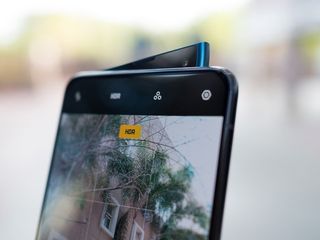
At a first glance, the Reno looks nearly identical to the OnePlus 7 Pro from the front. That's not by accident, as both devices have similar displays with razor-thin bezels, with the Reno coming in at 6.6 inches and the OnePlus 7 Pro at 6.67 inches. With both phones manufactured at the same factory, it's feasible that they're using a lot of the same components underneath.
But what sets the Reno apart is the shark fin popup camera up front, which houses the front camera module as well as the earpiece, and the dual LED flash for the rear cameras. There's also a microphone at the top of the popup shooter, and the entire assembly takes just under a second to engage. OPPO says the assembly can withstand 200,000 actuations, and it will automatically retract should it detect a fall to prevent any damage.
An exquisite design backed by a unique shark fin slider and a stunning color option.
The Reno is the culmination of OPPO's design efforts over the last two years. The phone shares a lot of design similarities with the R15 Pro and R17 Pro, with smooth flowing curves at the back and rounded corners. The Green Ocean color option is also stunning, and while it lacks the gradient pattern that we've seen on several phones this year, you do see a subtle shift in color.
The fit and finish is excellent, and OPPO has done a fantastic job to ensure that the camera lenses at the back are flush with the body of the phone. There is, however, a little nub just underneath the camera sensors that's likely to prevent them from getting scratched when laid flat on a table. There's also a vertical line that runs along the middle with OPPO branding and a designed by OPPO moniker, and the chrome accent serves to break up the design at the back.
Overall, the design is exquisite and makes the Reno look every bit as premium as the P30 Pro. The phone has a frosty finish at the back that gives it a metallic feel, but it is made out of glass and is just as prone to smudges as any other glass-backed phone. The glass itself is protected by a layer of Gorilla Glass 5. but just to be safe you're better off using the case that's bundled in the box. The case has a cutout at the back that highlights the OPPO branding, and it looks rather cool.





The power button is on the right and the volume rocker on the left, and the dual SIM card tray is at the bottom next to the USB-C port. On the other side of the charging port is the main speaker, with the secondary speaker tucked away behind the shark fin slider. There's no 3.5mm jack, and because of that triangular slider, the phone doesn't have any dust or water resistance. That's a real shame considering the segment the Reno is targeting, and you also lose out on wireless charging.
The phone itself is considerably larger from anything we've seen from OPPO thus far. Because of the optics for the 10x hybrid zoom lens at the back and the motorized slider up front — not to mention a 4065mAh battery — the Reno is heavy. In fact, at 215g, it's the heaviest phone in the market today.
With a height of 162mm and thickness of 9.3mm, the Reno is also quite tall and thick. To put things into context, the P30 Pro has a thickness of 8.4mm and weighs 192g. That extra 23g is immediately noticeable when you start using the Reno, and you will get fatigued when using the device in bed or taking a lot of photos and videos with it. This is not a phone you can use one-handed.
A gorgeous AMOLED display with no bezels makes gaming an absolute delight.
The front is dominated by a 6.6-inch FHD+ AMOLED display, and there are virtually no bezels around the panel. The effect is quite striking, and makes gaming an absolute delight on the phone. With a 93.1% screen-to-body ratio, the Reno is about as immersive as it gets. The display itself is vibrant, with saturated colors and excellent contrast levels. You get two display modes to choose from, and there's also the option to manually adjust the color temperature.
The secondary speaker on the slider leads to richer sound, and because of the notch-less design the Reno is a great phone for consuming media on the go. You even get a set of USB-C earbuds bundled in the box, and they sound pretty decent all things considered.
The display has 2.5D curves around the sides, and is backed by a layer of Gorilla Glass 6. Sunlight visibility is great, and the phone has Widevine L1 DRM for streaming high-def videos from Netflix and other streaming services. The one downside is that the panel has a standard 60Hz refresh rate and not 90Hz like the OnePlus 7 Pro — considering the close relationship both brands have, it would've been great to see a 90Hz display on the Reno.
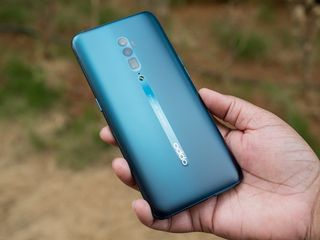
Continuing onto the hardware side of things, it's interesting to see OPPO use the flagship Snapdragon 855 chipset in the Reno. For the longest time, OPPO's devices featured mid-tier Snapdragon chipsets, with the high-end SoCs instead making their way to OnePlus. OPPO instead relied heavily on optimizing its software to deliver a smooth and lag-free experience, but with the brand increasingly focusing on global markets, it must've realized that a flagship chipset is needed to effectively compete in this segment.
The Reno goes toe-to-toe with the OnePlus 7 Pro on the hardware front.
Elsewhere, you'll find Wi-Fi ac with 2x2 MIMO, Bluetooth 5.0, NFC, 4G with VoLTE, dual SIM card slots, and a MicroSD slot — a feature that's missing from most phones at this price point. The phone is available with 6GB of RAM and 128GB of storage or 8GB of RAM and 256GB of storage.
Like most phones in this segment, the Reno features an optical fingerprint sensor. The sensor itself is fast and didn't pose too many problems, and in general is one of the better modules I've used this year.
As you'd imagine from the hardware on offer here, the Reno blazes through everyday tasks with ease. There's no slowdowns everywhere, and as I'll talk about in more detail below, ColorOS has been overhauled and no longer feels like an iOS clone.
The 4065mAh battery is more than adequate for a day's worth of use, and there wasn't a single instance where the battery level fell below 15% over the course of a day. I routinely got over six hours of screen-on-time, and that's at the higher end of what I usually see. The Reno comes with a 20W VOOC 3.0 fast charger in the box, and a full charge from flat takes just over 80 minutes.
OPPO Reno Software
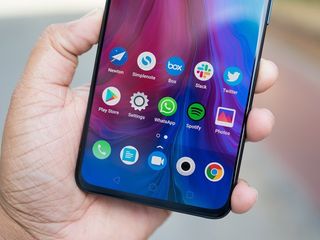
The main complaint with OPPO devices I've used in the past was ColorOS. The UI didn't really feel like a cohesive thought, and a lot of the elements were copied over from iOS. But with ColorOS 6, OPPO introduced a more modern interface with a new custom font, white menu elements interlaced with light colors, and an app drawer.
The interface itself is based on Android 9.0 Pie, and the new color scheme combined the addition of an app drawer makes ColorOS much more palatable to an international audience. Sure, the overview pane looks similar to what you get on iOS, but overall this is a pretty significant change from just a year ago.
The addition of an app drawer in particular makes a lot of difference in day-to-day usage. For the first time when reviewing an OPPO device, I didn't use a third-party launcher. The notification pane has also been overhauled, and is similar to what you get on other Android devices — there are quick toggles, a brightness slider, and actionable notifications.
ColorOS has come a long way in the last 12 months, but there's still a lot of bloatware.
While the interface itself is much more modern, there's still a lot of bloatware to deal with. Lock Screen Magazine shows you photos with text overlays of information you don't really need, and you'll have to manually disable the feature from the settings.
There's also the usual set of pre-installed apps, which include Dailyhunt, UC Browser, NewsPoint, Facebook, and Amazon, and like every other Chinese manufacturer, OPPO has its own app store.
You get the same set of features as other Chinese ROMs — there's a theming engine, ability to run two instances of an app, a Private Safe for hiding sensitive files, ability to lock apps with a password, granular notification management, and more. You also get a gaming mode called Game Space that automatically launches whenever you open a game, with the feature optimizing resources to deliver the best frame rates.
ColorOS also offers the ability to choose from various navigation styles — including switching to full-screen navigation gestures — and unlike most Chinese ROMs the memory management isn't so aggressive that apps in the background are automatically killed off. Overall, ColorOS has come a long way in the last 12 months, but OPPO has to cut down on the bloatware for it to stand out.
OPPO Reno About that 10x zoom

OPPO is marketing the Reno with 10x zoom, but the periscope lens at the back is only capable of 5x optical zoom — just like the P30 Pro. The app, however, cycles through 1x, 2x, 6x, and 10x zoom levels, and the last two are achieved with a combination of software and optics, or hybrid zoom.
Despite the marketing, the Reno relies on the same technology as the P30 Pro to deliver 10x zoom.
So in spite of OPPO's marketing efforts, the Reno isn't doing anything different from the likes of the P30 Pro. Both phones use hybrid zoom to hit that 10x zoom level, so I'm not entirely sure why OPPO is even plugging 10x zoom as the differentiator on the Reno. Even the 6x zoom factor is digital, and in terms of optics, the Reno delivers the same 5x optical zoom as the P30 Pro.
As for the hardware itself, there's a 13MP f/3.0 telephoto lens, an 8MP f/2.2 wide-angle shooter, and a 48MP f/1.7 primary camera that takes 12MP shots. Both the telephoto lens and wide-angle cameras are optically stabilized as well, and the camera relies on AI to automatically detect objects and scenes.
The viewfinder lets you easily switch between the Video, Photo, and Portrait modes, and there are more shooting modes hidden behind the hamburger menu: Night, Panorama, Manual, Slow-Motion, and Google Lens. You also get toggles for HDR, flash, settings, and there's a mode called Dazzle Color that boosts the contrast levels.
The Reno is using the same 48MP Sony IMX 586 camera module as the OnePlus 7 Pro, but you get much better photos in daylight and low-light shooting scenarios. OPPO has always done a better job tuning the cameras on its phones, and that fact is immediately evident once you start using the Reno.








Photos taken in daylight come out with lots of detail and high dynamic range, and colors look vibrant. The Reno also does a great job in situations where there's little to no lighting, with little to no noise. That said, the Reno isn't quite as good as the P30 Pro in low-light scenarios.


Reno on the left, P30 Pro on the right.
The Reno also loses out to the P30 Pro when it comes to the telephoto lens. At 5x zoom level you get much better detail and color accuracy on the P30 Pro, and that's the same when you switch to digital zoom as well. At 10x and even up to 25x the P30 Pro does a better job maintaining detail.
OPPO Reno Should you buy it?
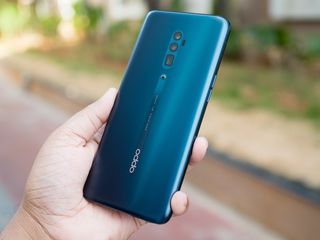
OPPO is selling the 8GB/256GB model of the Reno 10x Zoom Edition for £649 ($815), which is £50 less than the OnePlus 7 Pro in the country. In previous years, OPPO would've used a mid-tier Snapdragon chipset and focused its attention solely on the camera side of things, but with the Reno it is offering a flagship that goes toe-to-toe with the OnePlus 7 Pro, and that's no small feat.
The phone is similarly a great alternative to the P30 Pro. The telephotos lens isn't quite on the same level as what you get with Huawei's flagship, but it also costs £200 less than the P30 Pro in the UK.
The Reno holds its own against the best that Samsung and Huawei have to offer, and that's no small feat.
It's in India where the Reno truly shines. The 6GB/128GB variant of the device is available in the country for just ₹39,990 ($570), which is ₹10,000 ($145) less than the equivalent version of the OnePlus 7 Pro. Sure, you miss out on that stunning 90Hz display, but you're getting a much better camera, and that makes a more tangible difference in day-to-day usage.
If anything, the 5x optical zoom on the Reno gives it an edge over the OnePlus 7 Pro, and because it's rocking a 1080p display, you get much better battery life as well.
The 8GB/256GB edition is also very aggressively priced at ₹49,990 ($710). What that means is that the Reno is a fantastic deal in the Indian market, and if you're looking for a device with similar hardware as the OnePlus 7 Pro for ₹10,000 less, there really is only one choice. OPPO hasn't really been associated with value thus far, but as we've seen with the Reno, the company isn't afraid of changing its strategy.
To sum up, the Reno offers great hardware backed by an exquisite design and a capable 10x hybrid zoom lens. The 48MP primary camera is one of the best in this category, and ColorOS is no longer a limiting factor. Couple that with class-leading battery life and you get one of the best phones of 2019.
4.5 out of 5
The Reno is a viable alternative not just to the OnePlus 7 Pro, but the Galaxy S10+ and the P30 Pro. OPPO has delivered a phone that can stand up to scrutiny against the best that Android has to offer, and it has done so without compromising on any of the features that made its phones stand out in the first place.
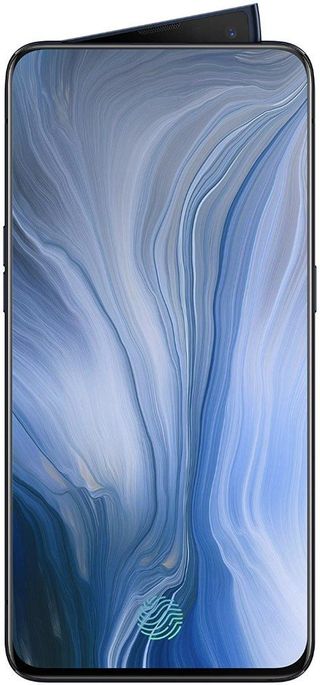
Stunning design backed by robust hardware and 10x zoom.
OPPO has managed to deliver a phone that can take on the P30 Pro. The notch-less design leads to an immersive experience when gaming, and you get the latest internal hardware backed by excellent battery life. The 10x hybrid zoom lens is a great new addition, as is the unique shark fin popup camera up front.

Harish Jonnalagadda is a Senior Editor overseeing Asia at Android Central. He leads the site's coverage of Chinese phone brands, contributing to reviews, features, and buying guides. He also writes about storage servers, audio products, and the semiconductor industry. Contact him on Twitter at @chunkynerd.
